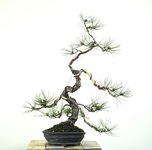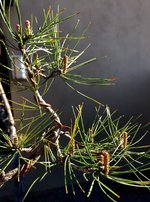PiñonJ
Omono
I visited Telperion in November 2019 to look for a JRP and this is what I brought home (well, to Mirai first). I did its first styling this past weekend.

I repotted it January 2020:

When classes went virtual last year, Ryan decandled it for me in June. Since in-person classes were cancelled again in November, I had them ship it to me. It arrived in very good shape, but the needle tips didn't like the trip.

I got to experience first-hand why the Japanese call these "glass pine." I did a wedge cut to bend the straight portion of the trunk and, during the bend, the outside portion of the bend cracked. Hopefully, there's enough xylem intact to keep the upper tree alive.


I repotted it January 2020:

When classes went virtual last year, Ryan decandled it for me in June. Since in-person classes were cancelled again in November, I had them ship it to me. It arrived in very good shape, but the needle tips didn't like the trip.

I got to experience first-hand why the Japanese call these "glass pine." I did a wedge cut to bend the straight portion of the trunk and, during the bend, the outside portion of the bend cracked. Hopefully, there's enough xylem intact to keep the upper tree alive.









